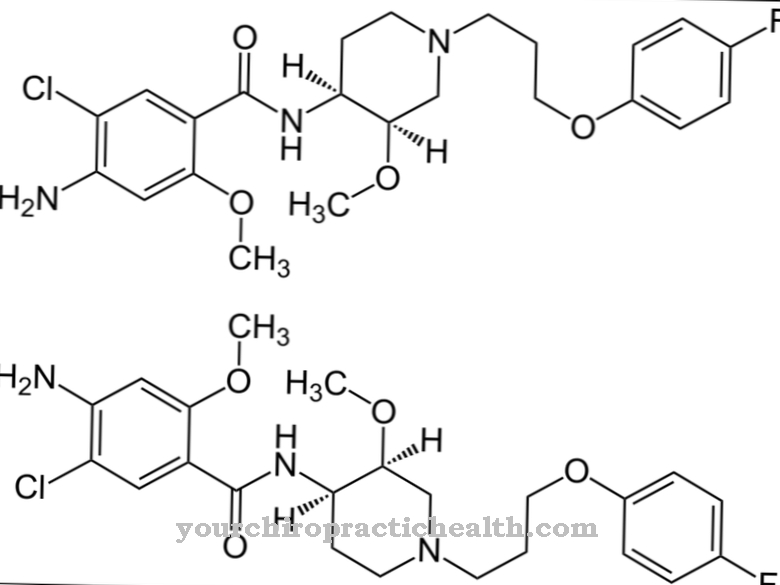Alprazolam is mainly used for anxiety and panic disorders. This active ingredient only treats the symptoms, not the cause of the discomfort. Due to the sometimes considerable side effects, alprazolam is only used when ingestion is unavoidable.
What is alprazolam?

Alprazolam was developed by the US pharmaceutical company Upjohn (later acquired by Pfitzer). It entered the German market in 1984 under the name Tafil®. The white, crystalline powder, practically insoluble in water, is one of the benzodiazepines.
In contrast to the classic representatives of this group, alprazolam has a triazole ring in the molecule. Hence it is also called triazolobenzodiazepine. This preparation is commercially available in the form of tablets and prolonged-release tablets, usually in doses of 0.25 mg, 0.5 mg or 1 mg. It is taken orally. The attending physician will determine the exact dosage.
Pharmacological effect
The fear-relieving, calming, relaxing and sometimes euphoric influence of alprazolam is based on its action on certain messenger substances in the brain. It crosses the blood-brain barrier and binds to the GABA-A receptors. There, the increasing influx of chloride ions intensifies the effect of the inhibitory neurotransmitter GABA within the central nervous system. This makes the nerve cells less sensitive to excitatory stimuli.
Eighty percent of the active ingredient taken as a tablet is absorbed into the bloodstream in the intestine.After a single oral dose, the maximum plasma level is reached after about one to two hours. Plasma protein binding is seventy to eighty percent. The volume of distribution is around 1.0 to 1.2 l / kg. However, it is significantly larger in obese patients. The plasma half-life is stated to be around twelve to fifteen hours, but can be longer in older male patients.
The biochemical conversion of alprazolam takes place in the liver. The active ingredient is mainly excreted in the urine. The delayed release of the active ingredient in prolonged-release tablets does not affect its distribution, metabolism or elimination. The peak serum concentration is reached with this form of drug approximately five to ten hours after ingestion.
Medical application & use
The main area of application of alprazolam is anxiety states with significant over-excitability (nervousness). It is also sometimes prescribed as adjunct therapy in the treatment of depression. This use is controversial among medical professionals.
Although the preparation has proven to be effective with a short treatment duration, the depressive symptoms can increase with longer administration. Therefore, the active ingredient is not suitable for the sole treatment of depression. Alprazolam is also often used as a sleep aid. However, there is no indication for this (off-label use). In higher doses, the drug can reduce muscle tension and help prevent epileptic cramps.
At the beginning, many patients receive 0.25 mg to 0.5 mg alprazolam three times a day. If necessary, the dose can be increased up to 3 mg daily. After ingestion, there may be memory lapses for the time immediately after use. It is therefore important to ensure that the treated persons sleep for a sufficiently long time.
You can find your medication here
➔ Medicines to calm down and strengthen nervesRisks & side effects
The most common side effects of alprazolam include drowsiness, drowsiness, and dizziness. Fatigue, reduced alertness, confusion, muscle weakness, headache, movement and gait insecurity, visual disturbances and tremors are also not uncommon at the beginning of treatment.
Taking this active ingredient can also lead to liver dysfunction, menstrual disorders, loss of appetite, nausea, constipation, hyperprolactinemia, skin reactions and changes in libido.
Children and the elderly may react aggressively after being given alprazolam and experience nightmares, irritability, restlessness and hallucinations. As soon as such symptoms appear, it is advisable to consult the attending physician and stop treatment with this drug.
Alprazolam can become physically and psychologically dependent even after a short period of time. The risk of dependence increases with the duration of use and the level of the dosage. Patients who have previously been addicted to alcohol, pills or drugs are particularly at risk. Abrupt discontinuation of the active ingredient causes anxiety, irritability, restlessness, headache and muscle pain, in extreme cases even loss of reality and personality or strong hypersensitivity reactions.
























.jpg)



